Chicken limone (also known as pollo al limone) is a classic Italian dish of pan-seared chicken cutlets simmered in a tangy lemon butter sauce. This easy recipe celebrates the fresh, vibrant flavors of the Mediterranean and comes together in under 30 minutes. It's my go-to dinner for busy weeknights or effortless entertaining because it's quick, reliable, and always bursting with flavor.
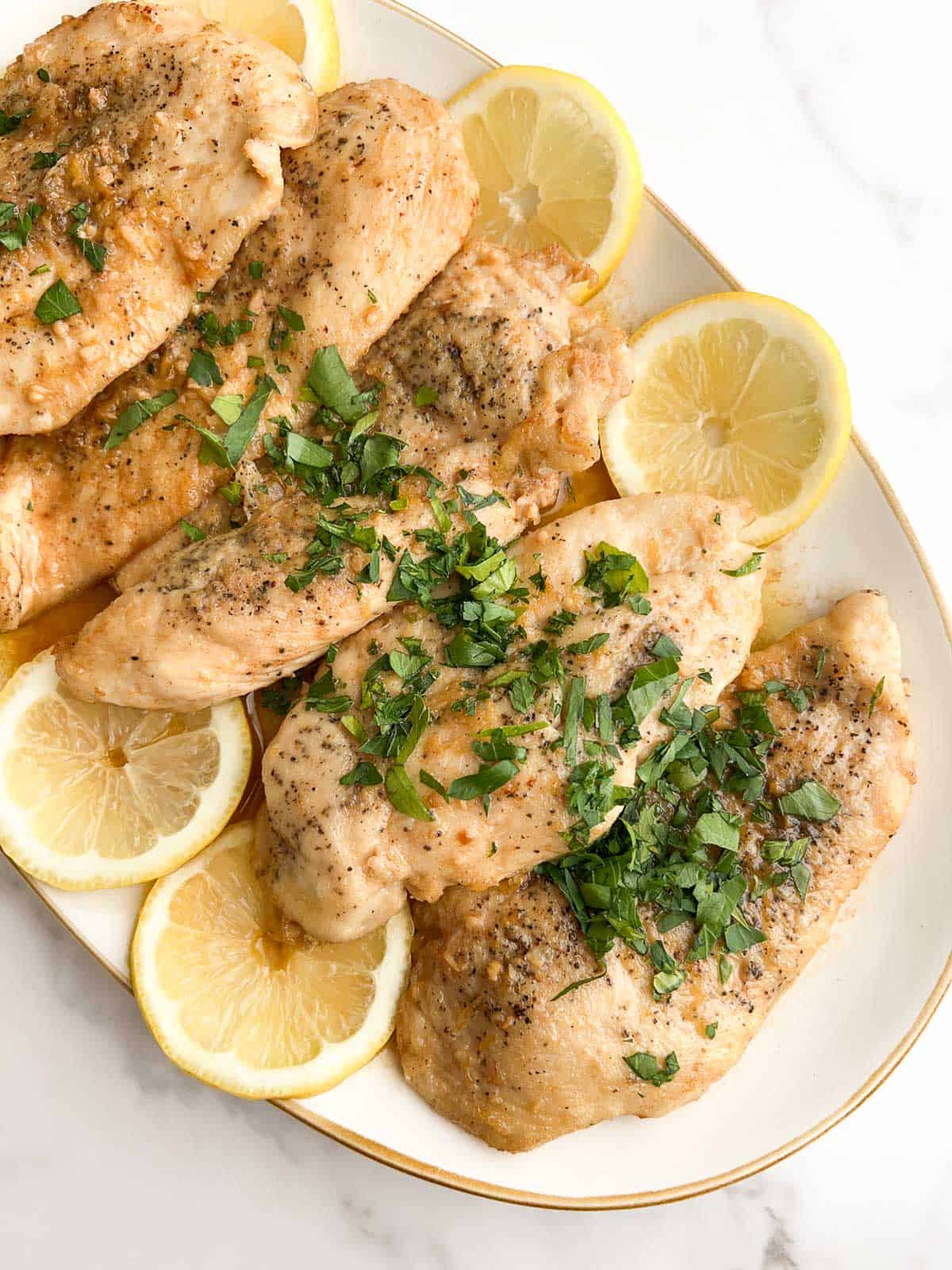
Save This Recipe! 💌
I've made this tender chicken limone more times than I can count, and it never fails to impress. Growing up in an Italian family, dishes like this were always a favorite at our table, with simple ingredients, bright flavors, and plenty of lemon.
If you've ever made chicken piccata, this recipe is similar but without capers and wine. Traditionally chicken limone is made by pan-searing thin cutlets, then simmering them in a simple sauce of lemon juice, butter, and broth. Unlike American versions that use heavy cream, this classic Italian method relies on butter to create a silky, golden sauce that coats each piece of chicken beautifully. Without cream, the sauce is lighter, brighter, and far more forgiving - you don't have to worry about it curdling!
I love serving chicken limone alongside my lemon caper pasta for a zesty, citrus-forward meal. It also pairs well with ricotta pesto pasta, where the creamy pesto balances the bright lemon sauce. Or try it with a simple Italian side like Ligurian focaccia to soak up every drop of the buttery sauce. You can even slice the chicken and serve it over my spinach and arugula salad, drizzled with white balsamic vinaigrette that complements the rich, savory flavors perfectly.
If you're looking for more delicious and easy chicken recipes, check out this crispy chicken milanese, air fryer chicken sausage and chicken minestrone soup.
Jump to:
Ingredients
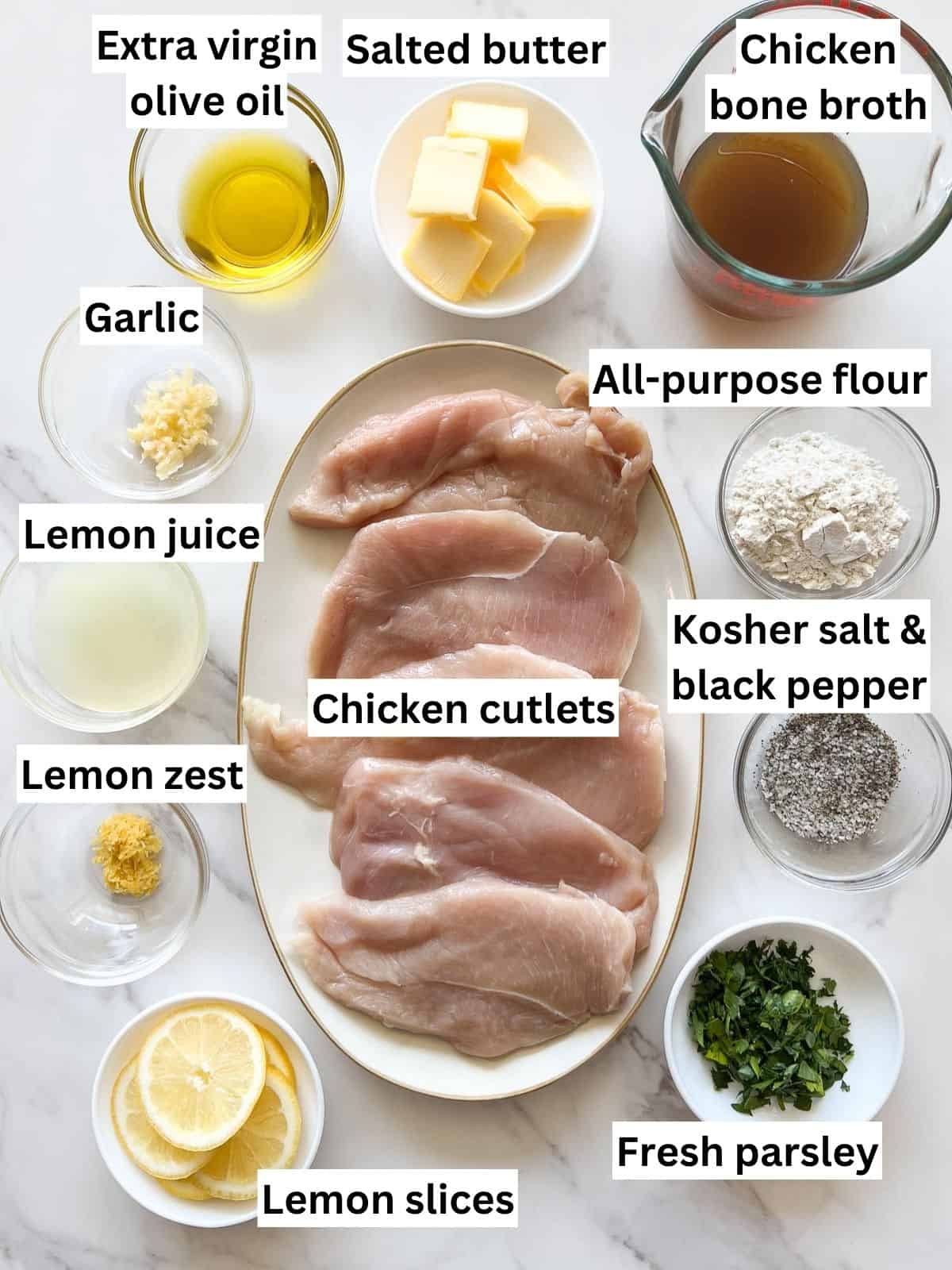
Ingredient Notes:
- Chicken cutlets: these are boneless, skinless chicken breasts sliced in half horizontally, then pounded to ¼-inch thick so they cook evenly without drying out. I prefer "air-chilled" chicken for extra tenderness and flavor. You can buy pre-sliced cutlets or make your own by halving chicken breasts lengthwise with a sharp knife before pounding them thin.
- Lemon juice: use freshly squeezed lemon juice for the best flavor. It gives the sauce a clean, bright acidity that bottled juice can't match.
- Lemon zest: this adds a burst of citrus that enhances the richness of the butter sauce. Use a fine grater or microplane to remove only the yellow outer layer of the peel. Avoid the white pith underneath which can taste bitter.
- Salted butter: I prefer salted butter because it simplifies the seasoning and enhances the lemon flavor. If you only have unsalted butter, add kosher salt to taste before serving.
- Chicken bone broth: this gives the lemon butter sauce extra body and depth thanks to its collagen and slow-simmered flavor. I love using bone broth in my Italian sauces, like mushroom pappardelle and tagliatelle alla bolognese, where it adds richness without being too heavy. Regular chicken broth works too; the sauce will be lighter but still delicious.
See recipe card for quantities.
Substitutions and Variations
- Use a different cut of chicken: boneless, skinless chicken tenders work well for a lighter option. For a deeper, richer flavor, try boneless chicken thighs. Adjust the cooking time accordingly; tenders cook quickly while thighs may need more time to reach temperature.
- Use a gluten-free flour: substitute an equal amount of gluten-free flour, like arrowroot or cornstarch. It browns nicely and keeps the same silky sauce texture.
- Make it dairy-free: replace the butter with olive oil. Be sure to use enough oil to lightly coat the bottom of the pan to prevent sticking. The sauce will be lighter and less creamy, so taste and adjust with a bit of salt to balance the flavor before serving.
- Add a hint of spice: a pinch of crushed red pepper flakes add subtle heat that brightens the lemon butter sauce without overpowering it.
- Make it extra creamy: traditional chicken limone doesn't include cream, but if you prefer a richer sauce, stir in a splash of room-temperature heavy cream at the very end of simmering. Add it off the heat to prevent curdling from the lemon juice. It's a modern twist that many love!
Instructions
💡Tip before you start: for extra juicy chicken, brine the cutlets first. Combine 1 tablespoon of kosher salt per cup of cold water and submerge the chicken for 15 to 30 minutes. Pat dry thoroughly before proceeding with the recipe.
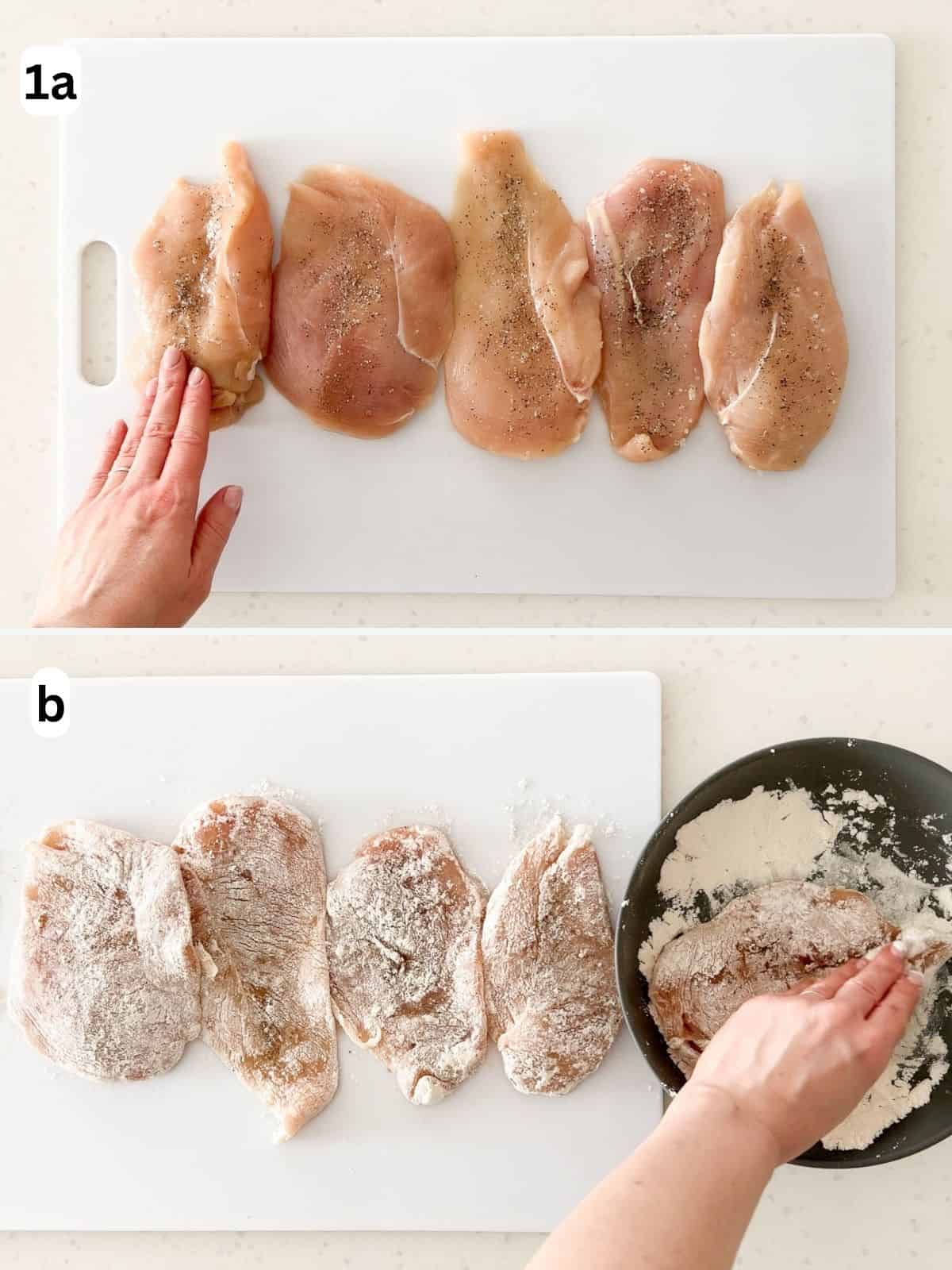
Step 1: place each chicken cutlet between two sheets of parchment paper and gently pound to ¼-inch thickness with a meat mallet or rolling pin. This helps them cook evenly and stay tender. Season both sides with salt and pepper (image 1a). Add the flour to a shallow bowl and lightly coat each cutlet, shaking off any excess (image 1b).
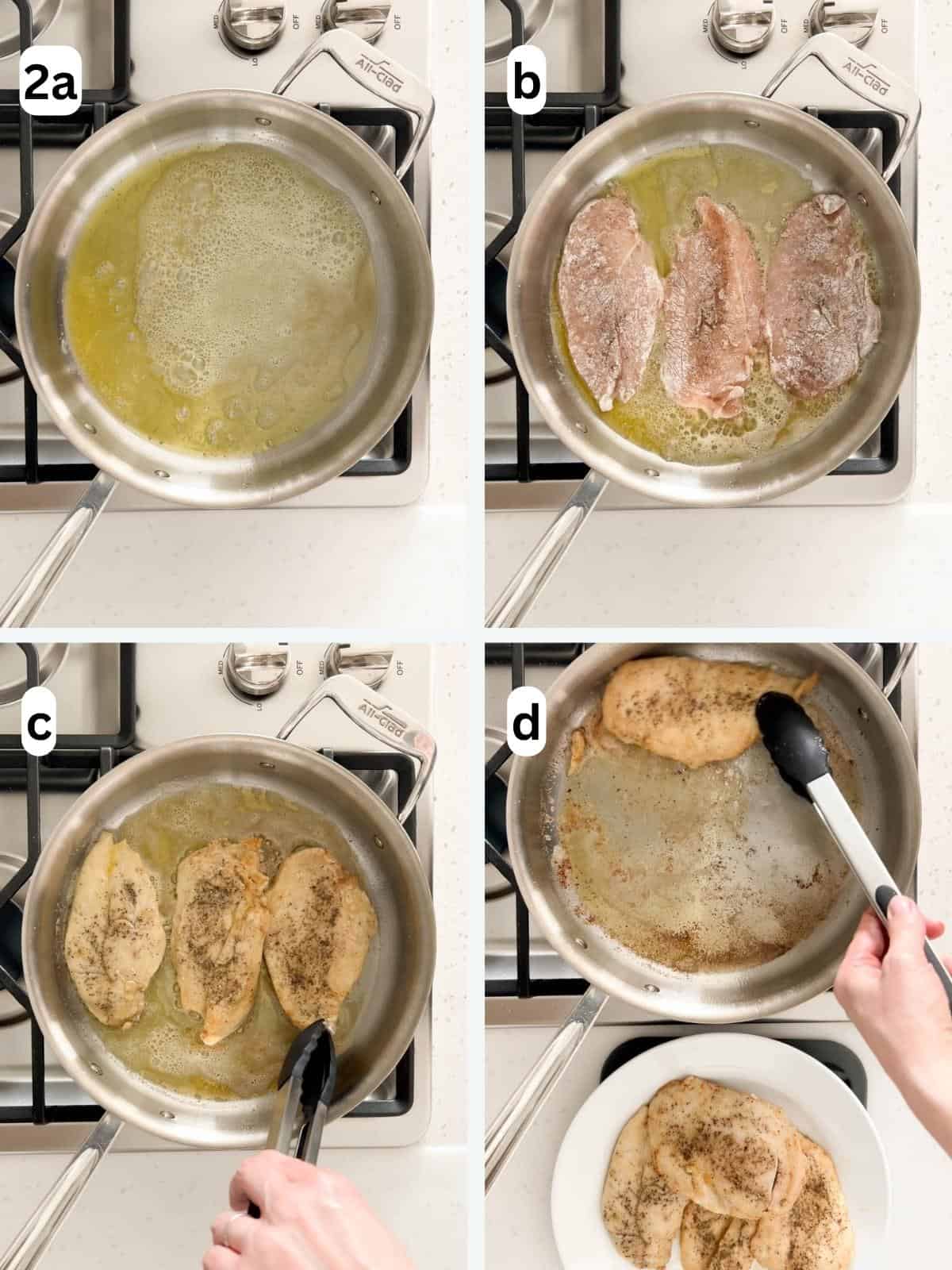
Step 2: in a large skillet, heat the olive oil and butter over medium heat (image 2a). Add the chicken cutlets in a single layer, working in batches if needed, and cook for 2 to 3 minutes per side (image 2b). When done, the chicken should be lightly golden but not fully cooked (image 2c); it will finish cooking later in the sauce. Transfer to a plate and set aside (image 2d).
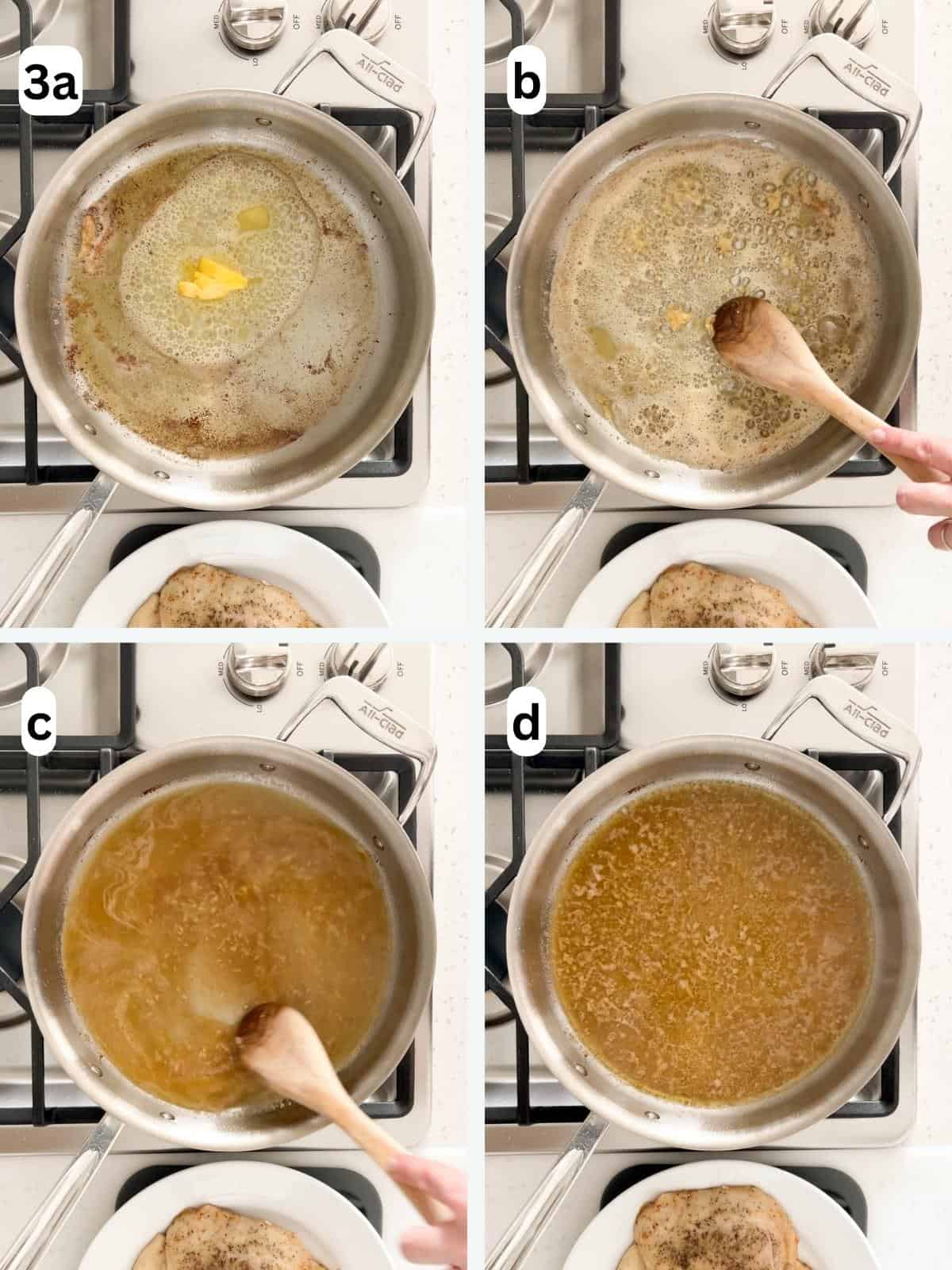
Step 3: in the same pan, reduce the heat to medium-low and melt the remaining butter (image 3a). Add the garlic and sauté for 1 minute, until fragrant (image 3b). Carefully pour in the bone broth and deglaze the pan, scraping up the browned bits with a wooden spoon (image 3c). Stir in the lemon juice and zest, then bring to a simmer for 3 minutes, until slightly reduced and thickened (image 3d).
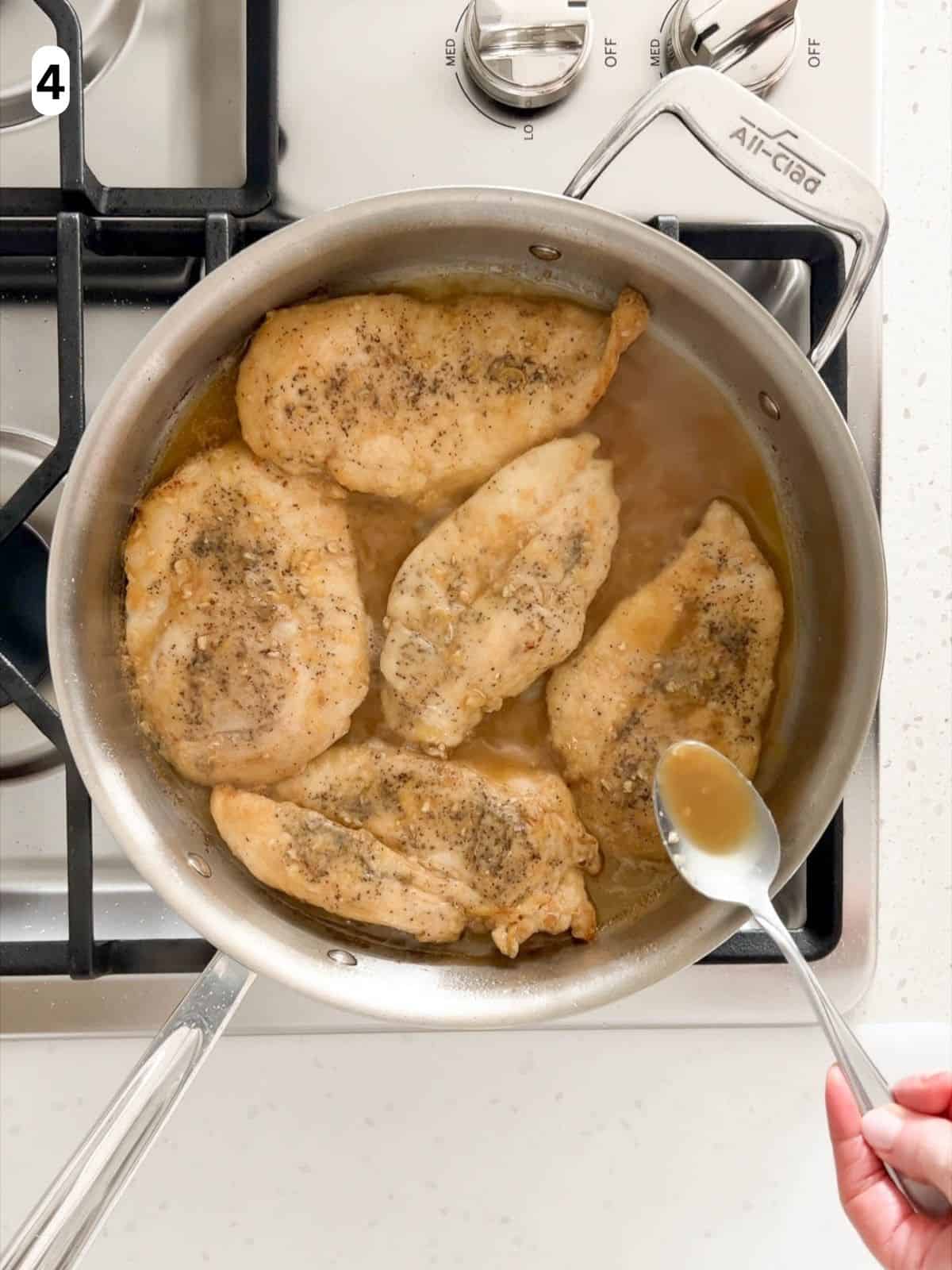
Step 4: return the chicken cutlets to the pan and simmer in the sauce for 2 to 3 minutes. Spoon the lemon butter sauce over them as they cook (image 4). Once the chicken reaches 165°F (74°C) throughout, remove from the heat. Transfer to a serving plate, pour the remaining sauce on top, and garnish with lemon slices and chopped parsley. Serve immediately and enjoy!
Storage & Reheating
- Storage: according to the USDA, leftover chicken can be stored in an airtight container in the refrigerator for 3 to 4 days or in the freezer for up to 3 months.
- Reheating: leftovers should reach 165°F (74°C) throughout before serving. If the sauce has thickened during storage, stir in a splash of bone broth or water to loosen it.
- stovetop: warm in a skillet over low heat, stirring occasionally, until heated through.
- microwave: transfer to a microwave-safe dish and cover lightly. Reheat in 30-second intervals, stirring and rotating between each, until the chicken is evenly heated.
For more information about how to store and reheat leftovers safely, check out this helpful USDA Leftovers and Food Safety guide.
Expert tips
- Handle raw chicken safely: wash your hands with warm, soapy water before and after handling raw chicken. Clean any surfaces or utensils with hot, soapy water to prevent cross-contamination, and use separate cutting boards for raw chicken and other foods. For more detailed guidance, see this CDC resource for handling raw chicken safely.
- Pound evenly for tender chicken: gently pound the cutlets to an even ¼-inch thickness before cooking. This helps them cook quickly and evenly without drying out. It's a top technique in Italian chicken dishes for achieving tender, perfectly cooked meat.
- Dredge lightly: shake off any excess flour from the chicken cutlets before cooking. A thin, even coating ensures a golden, crisp surface without turning gummy.
- Deglaze for depth: after adding the broth, scrape up all the browned bits from the bottom of the pan. This is where the flavor lives. These caramelized bits melt into the sauce, creating a rich, buttery base.
- Don't overcook the chicken: pan-sear the cutlets briefly to develop flavor, then let them finish cooking gently in the sauce. This method keeps the chicken juicy and allows it to absorb the bright lemon butter flavors without drying out.
FAQ
Chicken limone can become dry when the cutlets are an uneven thickness, not pounded thin, or overcooked during searing. Always pound to an even ¼-inch before cooking, and sear just to develop color. The chicken finishes cooking gently in the sauce. If you skip the gentle simmer, the meat can get dry.
If the chicken limone has too strong of a lemon flavor, stir in a tablespoon of butter or a splash of bone broth to balance the acidity.
Since this chicken limone recipe doesn't use cream, the sauce is naturally more stable and foolproof. However, even without cream, a lemon butter sauce can still separate if the pan is too hot when the lemon juice or butter is added. Keep the heat low and stir gently to help the sauce emulsify into a smooth and glossy texture.
Yes, you can add vegetables to chicken limone. Asparagus, bell peppers, or mushrooms pair perfectly with the lemon butter sauce. You can sauté them in the same pan after cooking the chicken, then toss them in the sauce for extra flavor or serve them on the side. They'll soak up the bright, butter flavors beautifully without adding extra steps.
Chicken limone pairs well with fresh salads and Italian pasta dishes. Because it is bright and citrusy, it goes especially well with burrata caprese or arugula and spinach salad. For pasta, try it alongside pasta al pesto, mushroom pappardelle, or bucatini pomodoro - all complement the lemon butter sauce perfectly. To finish the meal, serve an Italian dessert like Italian almond cake, chocolate ricotta cake, or salted caramel budino for the perfect sweet ending.
Related
Looking for more easy chicken recipes? Try these reader favorites:
Did you make this recipe? Leave a star rating and comment below! Subscribe to my newsletter for delicious Italian recipes straight to your inbox.
Recipe
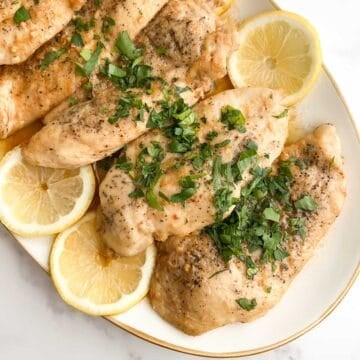
Chicken Limone
Save This Recipe! 💌
Ingredients
- 1 pound chicken cutlets *
- 1 teaspoon kosher salt
- ½ teaspoon black pepper
- ¼ cup all-purpose flour *
- 2 tablespoons extra virgin olive oil
- 4 tablespoons salted butter (divided into two, 2-tablespoon portions)*
- 3 cloves garlic (minced)
- ½ cup chicken bone broth *
- ¼ cup lemon juice (about 2 lemons)
- 1 teaspoon lemon zest *
- 2 tablespoons fresh parsley (chopped, for garnish)
- lemon slices (for garnish)
Instructions
- Season and dredge the chicken: for extra juicy chicken, you can brine the cutlets first (see Notes below). Place each cutlet between two sheets of parchment paper and gently pound to ¼-inch thickness using a meat mallet or rolling pin. Season both sides evenly with kosher salt and black pepper. Add the all-purpose flour to a shallow bowl and lightly coat each cutlet, shaking off any excess.
- Sear the chicken: in a large skillet, heat the olive oil and 2 tablespoons of butter over medium heat. Add the chicken cutlets in a single layer, working in batches if needed, and cook for 2 to 3 minutes per side until lightly golden. The chicken should not be fully cooked; it will finish later in the sauce. Transfer to a plate and set aside.
- Make the lemon butter sauce: in the same pan, reduce the heat to medium-low and melt the remaining 2 tablespoons of butter. Add the garlic and sauté for 1 minute until fragrant. Carefully pour in the bone broth and deglaze the pan, scraping up any browned bits with a wooden spoon. Stir in the lemon juice and zest, then bring to a simmer for about 3 minutes, until slightly reduced and thickened.
- Combine the sauce and chicken: return the chicken cutlets to the pan and simmer for 2 to 3 minutes, spooning the lemon butter sauce over them as they cook. Once the chicken reaches 165℉ (74℃) throughout, remove from the heat and transfer to a serving plate. Pour the remaining sauce over the top and garnish with lemon slices and chopped parsley. Serve immediately and enjoy!
Video
Notes
- Optional brine: for extra tender chicken, brine the cutlets first. Combine 1 tablespoon kosher salt per cup of cold water and submerge the cutlets for 15 to 30 minutes. Pat dry thoroughly with paper towels, then proceed with Step 1 of the recipe.
- Chicken cutlets: you can make your own by slicing 2 boneless, skinless chicken breasts in half lengthwise. You can also use chicken tenders for a lighter option or thighs for a richer flavor; just adjust the cooking time as needed.
- All-purpose flour: you can substitute with a gluten-free flour like cornstarch or arrowroot.
- Salted butter: you can use unsalted butter instead; just add kosher salt to taste before serving. For a dairy-free version, substitute with olive oil. Ensure there's enough oil to coat the bottom of the pan to prevent sticking.
- Bone broth: you can substitute with regular chicken broth. The flavor will be lighter but still delicious.
- Add a hint of spice: for gentle heat that complements the lemon butter sauce, add ¼ teaspoon of crushed red pepper flakes in Step 3, when adding the garlic.
- Make it extra creamy: some versions of chicken limone include cream for extra richness. Stir in a splash of room-temperature heavy cream at the end of Step 4, off the heat, to prevent curdling from the lemon juice.
- Food safety: wash your hands with warm, soapy water before and after handling raw chicken. Clean any surfaces or utensils with hot, soapy water to prevent cross-contamination, and use separate cutting boards for raw chicken and other foods. Cook the chicken to 165°F (74°C) throughout before serving. For more information, visit the CDC's guide for handling raw chicken safely.
- Equipment: a quick-read meat thermometer.
- Storage: leftovers can be stored in an airtight container in the refrigerator for 3 to 4 days, or in the freezer for up to 3 months.
- Reheating: leftovers should be reheated to 165°F (74°C) throughout before serving. If the sauce thickens, stir in a splash of bone broth or water to loosen it. For the stovetop: warm in a skillet over low heat, stirring occasionally, until heated through. For the microwave: transfer to a microwave-safe dish and cover lightly. Reheat in 30-second intervals, stirring and rotating between each, until the chicken is evenly heated.
Nutrition
The provided nutrition and storage information is estimated. Accuracy is not guaranteed.
See our Disclaimer for more information.
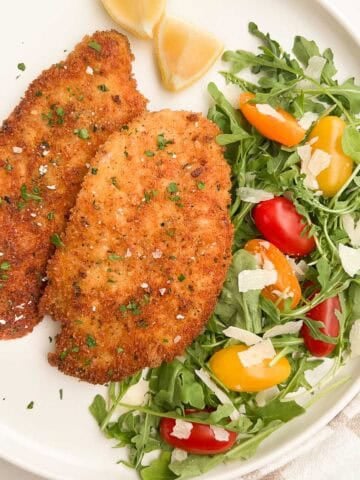

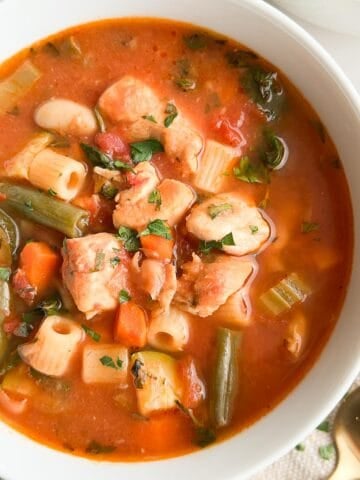
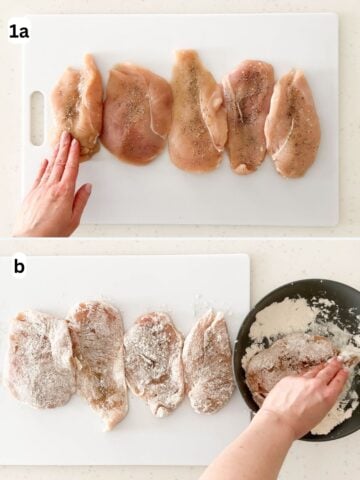
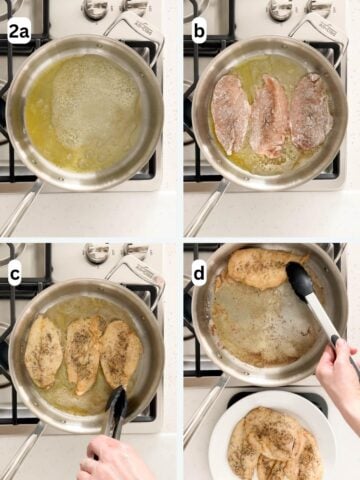
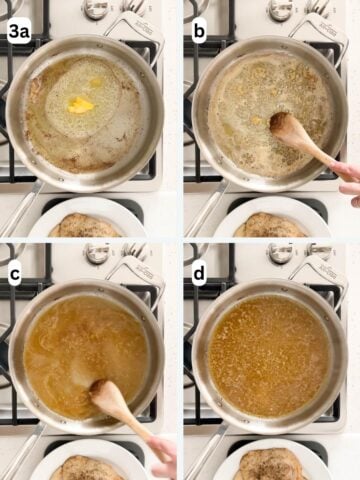
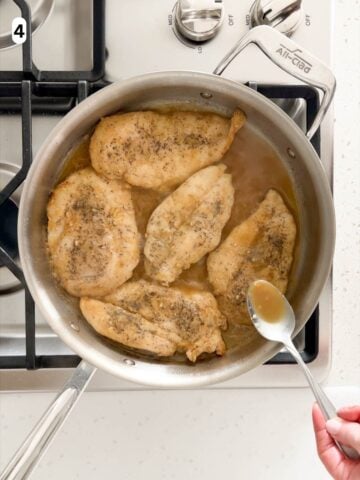
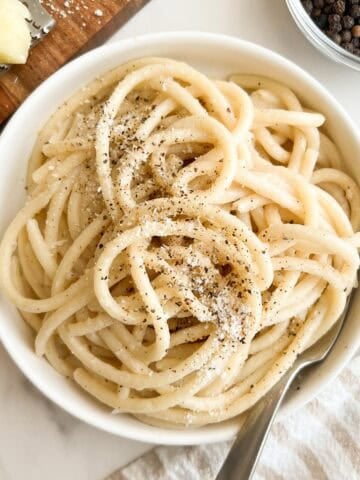
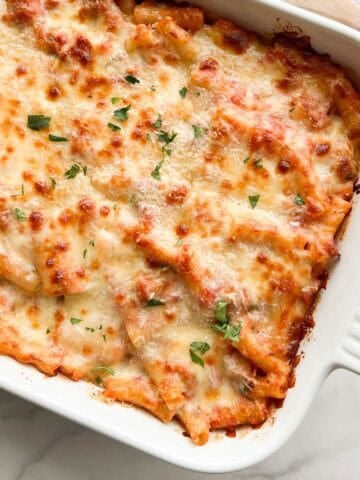
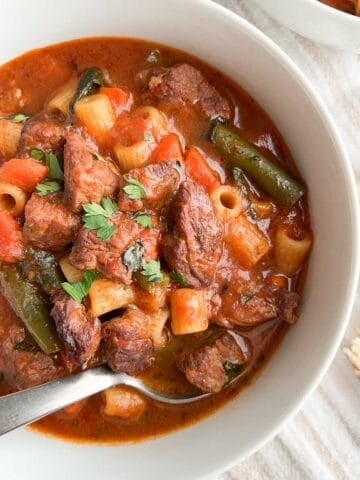
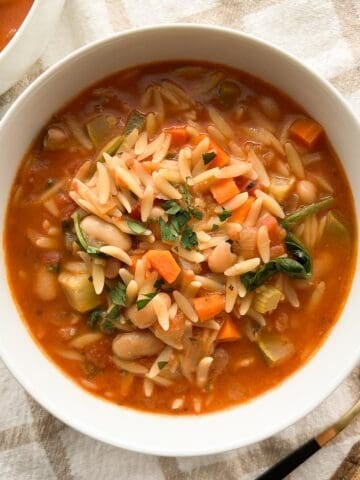
rd says
I love a good chicken dish, and this recipe does not disappoint. It is full of bright, fresh, lemony goodness. The sauce is delicate and delicious. The chicken comes out tender and juicy, with just the right amount of coating to enhance the flavor. The recipe itself is surprisingly easy! Your guests will think you are a gourmet cook when you put this meal in front of them. If you are looking for a tasty treat for your next chicken dinner, look no further!
Maria D'Errico says
Thank you, I'm glad you love the recipe. "Surprisingly easy" is a great way to describe it!